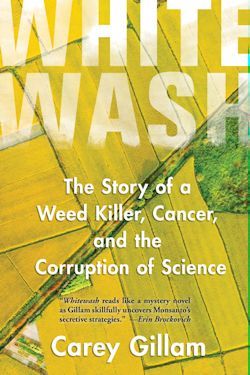SEJournal Online is the digital news magazine of the Society of Environmental Journalists. Learn more about SEJournal Online, including submission, subscription and advertising information.
BookShelf
“Whitewash: The Story of a Weed Killer, Cancer, and the Corruption of Science”
By Carey Gillam
Island Press, $30
Reviewed by Tom Henry
Give Carey Gillam credit. Even if Monsanto succeeds in discrediting her work — which she maintains it has been trying to do to her and others covering the glyphosate controversy — there’s nothing wishy-washy about this book.
She comes at one of the world’s most powerful corporations hard and doesn’t hold back, something legions of other journalists have been reluctant to do.
 |
“Whitewash” is a gutsy, compelling read from beginning to end, especially for readers who enjoy the kind of hard-nosed, shoe-leather reporting that used to be the hallmark of great journalism.
Gillam, a former Reuters correspondent with more than 25 years experience covering food and agricultural issues, makes a compelling case for a cover-up by Monsanto and the controversy surrounding its popular herbicide, Roundup, the world’s most popular weed killer.
Her book — hardly one Monsanto will find flattering — is bolstered by internal company documents, as well as those from within regulatory agencies that she asserts were efforts to downplay growing evidence against the product. The documents augment meticulous fact-finding and clues of malfeasance she pieced together over 20 years of reporting the story.
Glyphosate has become the most widely used agrichemical in history, so ubiquitous that Gillam’s book maintains it can be found in land, air, water and even human bodies anywhere near the multitude of places where it has been used, including farms, golf courses and backyards.
Much like the pesticide DDT, Gillam contends the herbicide glyphosate doesn’t live up to its safety claims and suggests the world is headed into unchartered territory because of Monsanto’s willingness to put corporate profits ahead of public health.
“This particular pesticide — glyphosate — is only one of scores of chemicals that have taken root in our lives, offering profits for the corporations that sell them but perils for the people exposed to them,” Gillam writes.
“Indeed, there is a large and expanding body of evidence tying various pesticide exposures to elevated rates of chronic diseases, including a range of cancers, diabetes, neurodegenerative disorders such as Parkinson’s disease and Alzheimer’s disease, birth defects, and reproductive disorders,” she notes, adding, “But the story of the world’s most widely used weed killer illustrates how destructive the consequences can be when we allow the balancing of risk and reward to tip too far in the direction of danger.”
“[It] illustrates how destructive the consequences can be
when we allow the balancing of risk and reward to tip
too far in the direction of danger.”
The jury’s still out on glyphosate, with regulatory agencies continuing to debate what to do with it — that is, whether a ban or phase-out is in order. And the book could have used more meaningful responses from Monsanto, if that was possible.
Gillam does what she can in terms of exposing what she believes has been a massive cover-up, contending her work is a clarion call for action.
It’s hard to read her book without at least finding her extensive research persuasive enough to warrant a more serious discussion of the issue. If right, she has done a great public service and shed light on decision-makers who need to be held accountable.
Tom Henry is SEJournal’s BookShelf editor.
* From the weekly news magazine SEJournal Online, Vol. 3, No. 9. Content from each new issue of SEJournal Online is available to the public via the SEJournal Online main page. Subscribe to the e-newsletter here. And see past issues of the SEJournal archived here.













 Advertisement
Advertisement 



